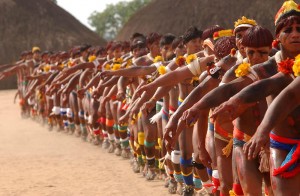Indigenous Brazilians Celebrate 50 Years Of Xingu Park
 [Editor’s Note: The following is a press release written by Fernanda Bellei, who is working with the festival from Brazil]
[Editor’s Note: The following is a press release written by Fernanda Bellei, who is working with the festival from Brazil]
From June 10 through 12, in the Kamaiurá village of Ipavu in the upper Xingu Park region, indigenous peoples of that area of Brazil will gather for traditional games, like Huka Huka, tug-of-war and archery, film screenings and debates about politics for indigenous peoples. The activities are part of a 50 year celebration of the creation of the Xingu National Park in Brazil; the park was created in 1961 in the state of Mato Grosso to protect the environment and the 6,152 indigenous people contained within the more than 16,400 square mile area (2.6 million hectares).
This is the first Cultural Festival of Xingu and is hosted by the Xingu Indigenous Land Association (ATIX), in partnership with other indigenous associations of Xingu, and has the support of the Instituto de Pesquisa Etno Ambiental do Xingu (IPEAX), Xingu-regional coordination of Fundação Nacional do Índio (Funai) and Instituto Socioambiental (ISA).
Xingu contains 16 ethnic groups: Kuikuro, Kalapalo, Matipu, Nahukuá, Mehinako, Waurá (Waujá), Aweti, Kamaiurá, Trumai, Yawalapiti, Kisêdjê (Suya), Kawaiwetê (Kaiabi), Ikpeng (Txicão), Yudja (Juruna), Naruvotu and Tapayuna. As well as 14 languages: Kamaiurá and Kaiabi (Tupi-Guarani family); Juruna (Juruna family); Aweti (Aweti family); Mehinako, Wauja and Yawalapiti (Aruák family); Kalapalo, Ikpeng, Kuikuro, Matipu, Nahukwá and Naruvotu (Karíb family); Suyá e Tapayuna (Jê family); Trumai (isolated language).
The Indigenous Park of the Xingu was created in April 1961, as a result of several years of work and political struggle. The park is recognized by UNESCO as an important set of cultural and linguistic diversity and was the first major indigenous land demarcation in Brazil. Its creation involved the Villas Boas brothers and important personalities such as Marechal Rondon, Darcy Ribeiro, Noel Nutels and Café Filho, among others.
Today, more than six thousand indigenous people live in the park. The south area of the park, known as the Upper Xingu, due to the geographical point, is home for the following peoples: Aweti, Kalapalo Kamaiurá, Kuikuro, Matipu, Mehinako, Nahukuá, Naruvotu, Wuaja and Yawalapiti. In the Middle Xingu, live the Trumai, Ikpeng, Kaiabi and Kamaiurá peoples and in Lower Xingu live the Ikpeng, Kaiabi and Yudjá. The east is home for the Kisêdjê (also know as Suya) and Tapayuna peoples.
The celebration of 50 years of Indigenous Park of the Xingu has different meanings for these peoples, who faced conflicts and changes of land and then settle.
Kumaré Ikpeng, one of the organizers of the Ikpeng people, says that this will be an important moment for the Xingu people. “During the festival, we will make a political reflection on the 50 year existence of the Indigenous Park of the Xingu and its future prospects. This celebration will be a milestone because it recovers our history since the time of contact until the present day and reflects the changes we have been through here.”
Winti Kisêdjê, president of Indian Association Kisêdjê (AIK), says that it is an especial opportunity to gather all the ethinic groups to think about the future of Xingu. “The 50 years festival is important to us, because it is a chance to analyze the political problems within the Xingu and outside of it as well. I hope this will help us build a single policy and unite the Xingu peoples.”
Andre Villas-Boas, coordinator of the Xingu Program from ISA, explains that the creation of the park was a social engineering. “The creation of Indigenous Park of the Xingu resulted in the concentration of groups of different ethinc origin within one single area and the release of the remaining land for the occupation on the regional context. It was a social engineering. Its boundaries were not discussed with indigenous peoples, and it was not the result of an anthropological report. There were no studies of the traditional forms of occupation to set the limits. At that time, it was merely an interpretation”.

